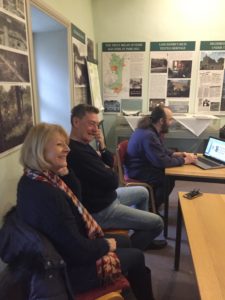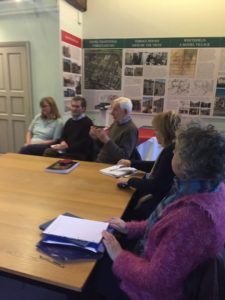We spent a very interesting and informative morning listening and looking at artefacts, most of them local, ranging in date from the upper paleolithic era to modern times. Alex Whitlock one of the Finds Liaison Officers for Lancashire and Cumbria revealed his knowledge of various finds that are logged by the Portable Antiquities Scheme or PAS. This body was set up after the Treasure Act specifically for the reporting of finds by the public.

PAG Group members Jan. 2020 with FLO Alex Whitlock. Attribution: GW
Apparently in the early Bronze Age (EBA) material for making implements was thought to be ‘brought by the gods”. From knapped flints which provided scrapers to axe technology, we were riveted… Interestingly and unusually one mesolithic flint was found with resin attached meaning that it would provide a suitable spot for attaching arrow heads or flints. In the mid BA technology shifted to socketed axes, spear heads had peg holes and loops to hold the implement in place. Flint and stone use continued into the Iron Age (IA). Past material was sometimes re used or re purposed in later years for example a neolithic flint core showed signs of being used again in the BA.

Members listening to the talk on PAS. Jan 2020. Attribution:GW
There was a copper alloy functional clothing pin from the (IA) some were of a lynch pin type, others a toggle arrangement. Late IA or early Roman harness rings and reins have also been found. Brooches in the Roman period have been found specific to Britannia. The use of currency started in the IA perhaps when the Romans traded with Britain before invading, sadly no local or north west currency has come to light – yet… There also seems to be a dearth of pottery, some Samian ware and black ware which were imported have been found.
The Anglo Saxon period was largely aceramic but that era has revealed a scabbard the top of which is gilded with a garnet. Early mediaeval times revealed coinage which was more simple, a step down from Roman currency then.. The post mediaeval period reveals a decorated spindle whorl, a find from earlier AS times is a sandstone loom weight found close to the Sen house in Maryport.
Alex stated that the finds that the public make help to re write history, these people include gardners, hikers, metal detectors. A good, relatively local example of this is the Cuerdale Hoard discovered in 1840 on the southern bank of the River Ribble near Preston. It is the second largest Viking hoard ever found and is displayed at the British Museum.
If you are interested in the history of Britain and your local area in particular it is well worth browsing the PAS website – https://finds.org.uk/ and an absolute must for amateur armchair archaeologists, you will find a box of delights.
Anyone for a walk along the River Ribble near Preston?
Did you know?
That a lead Roman weight was recyled – recoated – in recent times and the Vikings recycled an early mediaeval lead weight.
In the post mediaeval period a lead alloy hornbook was created and is to be seen on the PAS website.
That Elizabethan silver coinage is the purest silver coinage to be produced in Britain.
That Cistercian floor tiles found at Whalley are also to be found at Fountains Abbey and near Beverley. An example of early corporate branding perhaps?
Banner Image: Ceramic Floor tile at Whalley Abbey. Presently in Clitheroe Castle Museum. Photograph by Mike Peel (www.mikepeel.net